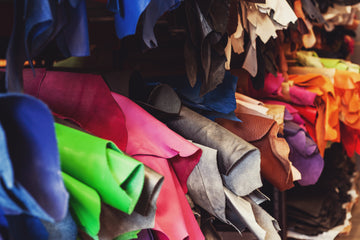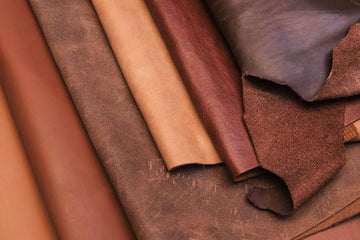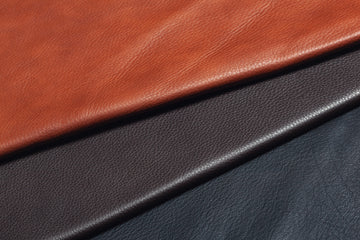A Comprehensive Guide to the Most Durable Leather Types
Introduction
Leather has been an attractive material for centuries because of its durability and aesthetic appeal. It has been used to decorate ancient armours and modern luxury goods. However, the longevity of leather varies widely and is not guaranteed. This comprehensive guide explores the factors that contribute to the durability of leather, providing insights for enthusiasts, consumers, and makers.
Understanding Leather: Types and Sources
Leather is a strong and durable material that has been used for centuries. It is made from the skin of animals, and its strength and longevity depend on the quality of the hide. The most common types of leather are cowhide, sheepskin, and goatskin. Cowhide leather is the most popular and is used in various products such as jackets, belts, and bags.
Sheepskin is known for its softness and is commonly used for jackets, boots, and gloves. Goatskin is a bit tougher and more water-resistant than cowhide and is often used for motorcycle jackets and boots. Choosing the correct type of leather for your needs is essential, as each type has unique characteristics and properties.
Cowhide
Cowhide, also called bovine leather, is a type of leather obtained from the skin of fully grown cattle. This material is highly valued and regarded as one of the most durable and sturdy in the leather industry due to its thickness, density, and toughness. Cowhide is a popular choice for a wide range of products exposed to wear and tear, such as furniture, automotive interiors, and equestrian gear.
One of the significant benefits of cowhide leather is its high resistance to scratches, punctures, and tears. This feature makes it an ideal material for manufacturing long-lasting and hard-wearing products that can withstand heavy usage over an extended period. Cowhide is also resistant to water and stains, making it suitable for moisture-sensitive items.
Another unique characteristic of cowhide leather is the patina that develops on its surface over time. This thin layer forms on the leather, giving it a unique appearance. This natural process occurs due to light, heat, and moisture exposure, adding to the leather's charm and character while maintaining its strength and durability.
In summary, cowhide leather is a versatile, robust, and long-lasting material that is an excellent choice for many products. Its inherent toughness and resistance to wear and tear make it a popular choice for items that need to withstand heavy usage, while its unique patina adds to its aesthetic appeal and charm.
Sheepskin and Goatskin
Sheepskin and goatskin are the fashion industry's most highly prized and sought-after leathers. With their intricate fibres and unique characteristics, these leathers offer a range of qualities that make them popular among designers and fashion enthusiasts.
Sheepskin, for example, is renowned for its delicate texture and softness, which comes from the fine wool fibres that make up the skin. This makes it lightweight and comfortable, perfect for creating elegant and luxurious garments and accessories. On the other hand, goatskin is prized for its suppleness and soft touch, which makes it an ideal choice for creating high-quality leather products that require both durability and flexibility.
Both types of leather offer a perfect balance of durability and flexibility, which is why they are often used in high-end fashion to create sophisticated and luxurious garments and accessories. From coats and jackets to shoes and handbags, these leathers are versatile and can be used to develop a variety of fashion items that exude elegance and style.
Despite their delicacy and softness, these leathers are incredibly durable and long-lasting, making them popular for those who value quality and substance in their fashion choices. Whether you prefer the delicate texture of sheepskin or the suppleness of goatskin, both types of leather are sure to add a touch of sophistication and elegance to any wardrobe.
Pigskin
Pigskin leather is a type of leather that is often overlooked despite its unique characteristics. It is a versatile material that is strong, durable, and flexible. The natural pore pattern of pigskin leather is distinctive and offers a unique aesthetic that sets it apart from other types of leather.
One of the most impressive qualities of pigskin leather is its balance of durability and flexibility. It is strong and can withstand wear and tear, making it a popular choice for athletic equipment and work gloves. Additionally, pigskin leather is flexible and soft, making it comfortable to wear and easy to move around.
Because of its unique properties, pigskin leather is used in various applications. It is commonly used to manufacture footballs, baseball gloves, and other athletic equipment. It is also utilised in producing work gloves, which require a sturdy and flexible material that can withstand heavy use.
In summary, pigskin leather is a hidden gem in the leather world that deserves more recognition. Its distinctive aesthetic and robust quality make it a versatile material that can be used for various applications.
The Tanning Process: A Crucial Factor
Turning raw animal hides into long-lasting leather is a complex art that relies heavily on the tanning process. The process involves a series of steps: cleaning, soaking, fleshing and picking the hides before they are tanned.
Tanning can be done using various methods such as vegetable tanning, chrome tanning, or synthetic tanning, each resulting in different types of leather with unique properties. The tanning process helps to transform the hides into a durable material that can be used to make a wide range of products, from shoes and bags to furniture and car seats.
Vegetable Tanning
Imagine a centuries-old process that involves soaking leather in organic materials like tree bark and leaves. This is the essence of vegetable tanning, producing eco-friendly leather that ages gracefully. The resulting leather is firm at first but gradually softens with use. This makes it a perfect choice for making durable and high-quality belts, saddles, and heritage bags that can withstand the test of time.
Chrome Tanning
Chrome tanning was invented in the 19th century, and it involves the use of chromium salts to achieve a faster and more uniform result. The resulting leather is known for being water-resistant and pliable, making it ideal for both fashion-forward and everyday wear.
However, it is essential to note that chrome tanning is less eco-friendly than vegetable tanning and may result in a different rich patina over time. Despite this, it remains a popular choice for leather production due to its efficiency and versatility.
Finishing Touches: Dyes and Coatings
After the tanning process, the leather undergoes post-tanning treatments that play a crucial role in determining the final characteristics of the material. These treatments involve a series of steps, such as retaining, dyeing, and fatliquoring, which help to enhance the leather's durability, colour, and texture. The quality and effectiveness of these treatments are crucial in determining the overall quality of the leather and its suitability for various applications.
Dyes
Leather dyes are crucial in colouring and enhancing leather products' durability. High-quality dyes provide vibrant colours and penetrate deeply into the material to keep the colour intact for a long time.
In addition, these dyes can prevent premature fading and cracking, often caused by exposure to sunlight and other environmental factors. Therefore, choosing a suitable leather dye is essential to maintain the quality and longevity of leather products.
Coatings
Leather products are often coated with protective substances, such as waxes, oils, or synthetic finishes, to safeguard them from environmental factors that could damage or deteriorate the leather. These coatings serve several functions, including improving water resistance, providing UV protection, and enhancing resistance to scratches. By doing so, they can significantly extend the lifespan of the leather product, maintaining its quality and appearance over time.
Cutting and Stitching
Skilled artisans possess a deep understanding of the properties of leather, allowing them to carefully cut the material in a way that maximises its inherent strength and resilience. They also have a keen eye for detail and know how to strategically place seams and align the leather grains to ensure the finished product is durable and aesthetically pleasing.
In addition, they use high-quality thread that is resistant to wear and tear, further contributing to the item's longevity. These expert craftsmanship techniques result in leather goods that stand the test of time and can be enjoyed for years.
Maintenance
Proper care is vital to maintain the durability of leather items. Regular cleaning and conditioning are essential to keep the material supple and prevent cracking, which could shorten the item's lifespan. Leather conditioners play a crucial role in protecting the leather from harsh environmental conditions that it may be exposed to. Using such conditioners extends the life of leather items such as boots and jackets.
It is recommended that these items be cleaned and conditioned regularly to ensure their longevity and to maintain their appearance. In conclusion, proper care and maintenance of leather items are necessary to keep them looking their best and ensure they last for many years.
Sustainable Sourcing
The process of sourcing leather from farms prioritising sustainable and humane animal-rearing practices is crucial in ensuring the quality and durability of our leather products. Ethically sourced leather typically comes from animals raised in healthier environments and are therefore less likely to develop skin ailments. This, in turn, leads to leather that is of a higher quality, more durable, and longer-lasting. Ultimately, choosing to use ethically sourced leather is a more responsible and compassionate choice and results in a better end product with numerous benefits.
Ethical Treatment and Production
Consumers become more conscious about environmental issues and animal welfare, so the fashion industry is pressured to adopt sustainable and ethical practices. This includes using eco-friendly tanning processes that minimise the environmental impact and adopting fair labour practices that promote safe and healthy working conditions for all workers.
These measures contribute to the final product's quality and increase its desirability among consumers who value sustainability and ethical production methods. Adopting these practices can help the fashion industry reduce its environmental impact and promote more responsible production methods.
Enhancing Leather's Longevity
The lastingness of leather is significantly influenced by its maintenance and care. Regular and appropriate cleaning, conditioning, and safeguarding can substantially prolong the life of leather items.
Below are essential guidelines to bolster the endurance of your leather goods:
- Regular Cleaning: Gently wipe off dirt and dust using a soft, lint-free cloth or a brush for leather care.
- Conditioning: Periodically apply a quality leather conditioner to maintain moisture, preventing the leather from drying and cracking.
- Waterproofing: Employ a waterproof or water-resistant spray tailored for leather to protect it from moisture damage.
- Avoid Heat and Direct Sunlight: Continuous exposure to high heat and sunlight can lead to the fading and weakening of leather, making it prone to brittleness.
- Gentle Handling: Exercise caution in handling leather products, avoiding excessive force or stretching.
- Proper Storage: Store leather items in a cool, dry environment. Avoid using plastic bags or sealed containers; opt for breathable fabric bags instead.
- Professional Cleaning: For high-value or extensively stained leather pieces, it's advisable to consult a professional cleaner equipped with the appropriate tools and expertise for leather care.
Conclusion
Regarding leather, durability is a crucial factor that every leather lover looks for. High-quality materials, such as full-grain leather, combined with precise and thoughtful craftsmanship, can produce leather goods that are elegant, beautiful, and incredibly long-lasting. However, leather's durability is determined by the quality of materials and craftsmanship and the ethical and sustainable practices employed in production.
Leather produced using ethical and sustainable practices has a lower carbon footprint. It is more durable and resilient, making it a perfect choice for those who want to invest in leather goods that will stand the test of time.
In summary, by choosing leather products made from high-quality materials, crafted with precision, and produced using ethical and sustainable practices, you can be sure that your leather goods will endure and age gracefully, becoming treasured items that can withstand the test of time.
UK's No.1 Leather Supplier & Wholesaler
We invite you to explore our latest durable leather hides and skins. Our premium leather selection represents quality and craftsmanship from the finest tanneries worldwide. Whether embarking on a new project or replenishing your materials, you'll find exactly what you need in our extensive range.
🔗 Shop the most durable leather hides
If you have any questions about the various types and grades of leather used for your next leather crafting project, please don't hesitate to contact us. We are here to help you better understand each type of leather so you can choose the right one that not only enhances the aesthetics of your bag but also ensures its longevity.






